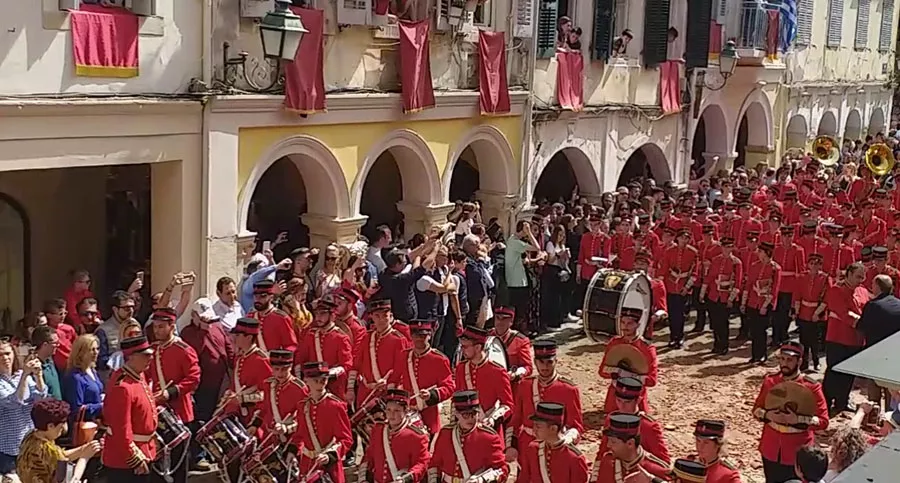
Easter In Corfu
Easter in Corfu is unique!
If you have already been to Corfu, you know its beauty, but if you haven’t been to this Greek island during Easter you have seen nothing yet! The endless festivity and brightness of these days will make you fall in love with Corfu while giving you a reason to return every year! Easter is the biggest festival of the Greek Orthodox Church and visiting Corfu these days is an exciting experience. Thousands of visitors, Corfiots, and both Orthodox and Catholic churches celebrate together as a huge family. Although Catholic Easter is not celebrated on the same days as Orthodox Easter, the Catholic church participates in the festivities too. Great local cuisine with delicious traditional food, lots of Greek and Corfiot in particular customs and events which take place every day, spiritual music from the Corfiot Philarmonic bands, and the spring which is at its beginning, make up an enchanting scene. Easter in Corfu is spectacular, impressive, and glorious more than anywhere in the world!
Holy Week ceremonies begin on Palm Sunday
At 11.00 am the procession of the Holy Shrine of Saint Spyridon takes place commemorating the miracle of the Saint who expelled the plague from the island back in 1629. All the Philharmonic bands of Corfu (18 in total) participate in this ceremonial event. On the same evening, the “Mantzaros” Philharmonic presents a concert at the Municipal Theater and leads us in the mood of the Holy Week. More events take place during the Holy Week. Hymns in churches, choirs, and music events in the squares and Municipal theater are always in the mood of Passion Week.
On Good Friday Christ’s descent from the cross is commemorated. In each church, young girls decorate the Epitaphs with flowers. Early in the afternoon until late at night, each Epitaph makes its circumambulation in the streets followed by the faithful until they all meet in the historic center of Corfu Town. The last Epitaph and the most impressive is the Epitaph of Corfu Cathedral which makes its appearance at 10 pm, accompanied by the mournful music of the three main Philharmonic bands. The “Old” Philharmonic (red) performs Albinoni’s Adagio, the “Mantzaros” Philharmonic (blue) performs Verdi’s Marcia Funebre and the “Kapodistrias” Philharmonic plays Mariani’s Elegia Funebre.
On Great Saturday the earthquake that followed Christ’s Resurrection is represented by an artificial earthquake at 6.00 am at the church of the Virgin “Madonna of Foreigners”. Later, the procession of the relics of Saint Spyridon takes place in the narrow street of the Old City commemorating the deliverance of the island from the famine, accompanied by mournful music from the Philharmonic bands.
At 11.00 am the bells announce the “morning Resurrection” and the mood becomes joyful and festive! Corfiots make noise while throwing large red clay of windows and balconies! There are two theories for this custom. The one reminds the Venetians who used to throw old things at New Year so that the coming year would bring them new. The second theory says that by throwing old things and making noise they celebrate the coming of the spring. After throwing the clays the Philharmonic bands play music….and you will certainly see a group of traditional dancers around there! People say “Christos Anesti” to one another which means “Christ is risen” and the response is “Alithos Anesti” which means “He has truly risen”.
At 12.00 midnight the most spectacular and impressive event, the Resurrection Mass takes place at the bandstand on the Upper Esplanade square with many Philharmonic bands and thousands of people. And when the Bishop chants “the Risen Christ” hundreds of exciting fireworks illuminate the sky making this experience unforgettable.
On Easter Sunday things become quieter!
In every church, there is a procession of the Resurrection. Corfiots with their families and friends roast the lamb on a split and crack red eggs. Throughout the island lots of festivities take place and everyone is welcome to participate. The menu of Easter days includes “red eggs” which are dyed red on Holy Thursday. People crack those red eggs after the Resurrection at midnight and on Easter Sunday while saying the phrases “Christos Anesti” and “Alithos Anesti” to one another. This custom symbolizes the resurrection and the beginning of a new life cycle. “Tsilichourda” a soup that is eaten after the Resurrection at midnight, Easter cakes called “fogatsa” and the roasted lamp which is often accompanied by the “kokoretsi” on a second, smaller one split on Easter Sunday.
Stay at Villa 1870 Corfu and enjoy the Easter days feeling part of the villa’s family! Enjoy the local menu prepared by the private villa’s chef, especially for you, and let the driver take you to the historical center of Corfu (5 – a minute’s drive) where the Easter events take place. Swim in the salted swimming pool which will be heated in case the sun and temperature are not warm yet! Of course, don’t miss out on the chance that spring offers to explore the whole island of Corfu!
Invite the whole family or your friends to enjoy a luxurious and exciting Easter with you! Villa 1870 Corfu can accommodate up to 16 people!
Happy Easter to everybody!



